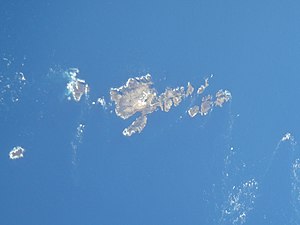Casquets
| Casquets | |
|---|---|
| Aerial view of the casquets | |
| Waters | English Channel |
| archipelago | Channel Islands |
| Geographical location | 49 ° 43 ′ N , 2 ° 23 ′ W |
| Main island | Peclua la Fourche |
| Total land area | 0.03 km² |
| Residents | uninhabited |
|
Les Casquets west of Alderney on the 18th century map |
|
The Casquets are a small group of rocks in the English Channel 13 km west of Alderney , one of the Channel Islands off the French coast . The rock group is marked with a lighthouse and belongs to the Bailiwick of Guernsey .
history
Originally, all of the Channel Islands were part of the lands of the Duke of Normandy . In 1066, Duke William the Conqueror conquered England and became King of England. The Channel Islands remained in royal possession. The first lighthouse on the until then mostly uninhabited island was built in 1724. During the Second World War , the Channel Islands were occupied by the German Wehrmacht . Seven men of the island crew were on 2/3 Captured September 1942 in an English commando company .
Due to their exposed position, the casquets pose a great danger to ships; Numerous accidents occurred there over time. As early as 1724, three coal fires were installed in lanterns on the largest rock, and in 1790 they were replaced by three connected lighthouses with oil lamps and metal reflectors. In 1877 the three lights were replaced by one. The lighthouse is still in operation in this form, albeit automated since 1990 and without a lighthouse keeper .
Casquets' victims include B. the British liner HMS Dragon , which ran aground on March 16, 1712 while escorting a convoy . The remains of the wreck (corroded cannons and concretions ) extend in the eastern area of the casquets from the flat area to a depth of about 40 m. Another shipwreck was the sinking of the passenger ship Stella , which hit Black Rock in fog on March 30, 1899 en route from Southampton to Guernsey . Of the 217 people on board, 105 were killed. The wreck was discovered in 1973 about a nautical mile west of the rocks at a depth of about 56 meters.
The Casquets have long been associated with one of the greatest shipping disasters in British waters: the sinking of the liner Victory on October 5, 1744, in which the entire crew of around 1150 men lost their lives. When the wreck was found in 2008, about 100 nautical miles west of the assumed disaster site, it became clear that the chain of rocks was not responsible for the sinking. Rather, it is now assumed that the ship's construction and maintenance were faulty, which ultimately capsized it in a violent storm .
- gallery




